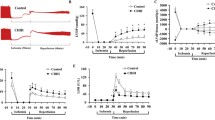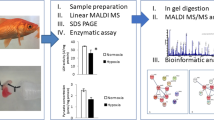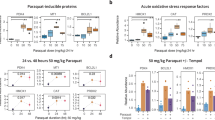Abstract
Normobaric hyperoxia is applied for the treatment of a wide variety of diseases and clinical conditions related to ischemia or hypoxia, but it can increase the risk of tissue damage and its efficiency is controversial. In the present study, we analyzed cardiac mitochondrial proteome derived from guinea pigs after 60 h exposure to 100% molecular oxygen (NBO) or O2 enriched with oxygen cation (NBO+). Two-dimensional gel electrophoresis followed by MALDI-TOF/TOF mass spectrometry identified twenty-two different proteins (among them ten nonmitochondrial) that were overexpressed in NBO and/or NBO+ group. Identified proteins were mainly involved in cellular energy metabolism (tricarboxylic acid cycle, oxidative phosphorylation, glycolysis), cardioprotection against stress, control of mitochondrial function, muscle contraction, and oxygen transport. These findings support the viewpoint that hyperoxia is associated with cellular stress and suggest complex adaptive responses which probably contribute to maintain or improve intracellular ATP levels and contractile function of cardiomyocytes. In addition, the results suggest that hyperoxia-induced cellular stress may be partially attenuated by utilization of NBO+ treatment.






Similar content being viewed by others
References
Dekleva M, Neskovic A, Vlahovic A, Putnikovic B, Beleslin B, Ostojic M (2004) Adjunctive effect of hyperbaric oxygen treatment after thrombolysis on left ventricular function in patients with acute myocardial infarction. Am Heart J 148:e14
Sjöberg F, Singer M (2013) The medical use of oxygen: a time for critical reappraisal. J Intern Med 274:505–528
Shi SH, Qi ZF, Luo YM, Ji XM, Liu KJ (2016) Normobaric oxygen treatment in acute ischemic stroke: a clinical perspective. Med Gas Res 6:147–153
Moradkhan R, Sinoway LI (2010) Revisiting the role of oxygen therapy in cardiac patients. J Am Coll Cardiol 56:1013–1016
Wang C-H, Chang W-T, Huang C-H, Tsai M-S, Yu P-H, Wang A-Y, Chen N-C, Chen W-J (2014) The effect of hyperoxia on survival following adult cardiac arrest: a systematic review and meta-analysis of observational studies. Resuscitation 85:1142–1148
Hafner S, Beloncle F, Koch A, Radermacher P, Asfar P (2015) Hyperoxia in intensive care, emergency, and peri-operative medicine: Dr. Jekyll or Mr. Hyde? A 2015 update. Ann Intensive Care 5:2–14
Guensch DP, Fischer K, Shie N, Lebel J, Friedrich MG (2015) Hyperoxia exacerbates myocardial ischemia in the presence of acute coronary artery stenosis in swine. Circ Cardiovasc Interv 8:e002928
Jiménez J, Richter J, Nagatomo T, Salaets T, Quarck R, Wagennar A, Wang H, Vanoirbeek J, Deprest J, Toelen J (2016) Progressive vascular functional and structural damage in a bronchopulmonary dysplasia model in preterm rabbits exposed to hyperoxia. Int J Mol Sci 17:1776
Panguluri SK, Tur J, Fukumoto J, Deng W, Sneed KB, Kolliputi N, Bennett ES, Tipparaju SM (2013) Hyperoxia-induced hypertrophy and ion channel remodeling in left ventricle. Am J Physiol Heart Circ Physiol 304:H1651–H1661
Chapalamadugu KC, Panguluri SK, Bennett ES, Kolliputi N, Tipparaju SM (2015) High level of oxygen treatment causes cardiotoxicity with arrhythmias and redox modulation. Toxicol Appl Pharmacol 282:100–107
Spoelstra-de Man AME, Smit B, Oudemans-van Straaten HM, Smulders YM (2015) Cardiovascular effects of hyperoxia during and after cardiac surgery. Anaesthesia 70:1307–1319
Asfar P, Singer M, Radermacher P (2015) Understanding the benefits and harms of oxygen therapy. Intensive Care Med 4:1118–1121
Arab A, Wang J, Bausch K, von Schmädel K, Bode C, Hehrlein C (2010) Transient hyperoxic reoxygenation reduces cytochrome c oxidase activity by increasing superoxide dismutase and nitric oxide. J Biol Chem 285:11172–11177
Geng X, Fu P, Ji X, Peng C, Fredrickson V, Sy C, Meng R, Ling F, Du H, Tan X, Hüttemann M, Guthikonda M, Ding Y (2013) Synergetic neuroprotection of normobaric oxygenation and ethanol in ischemic stroke through improved oxidative mechanism. Stroke 44:1418–1425
Geng X, Parmar S, Li X, Peng C, Ji X, Chakraborty T, Li WA, Du H, Tan X, Ling F, Guthikonda M, Rafols JA, Ding Y (2013) Reduced apoptosis by combining normobaric oxygenation with ethanol in transient ischemic stroke. Brain Res 1531:17–24
Bader N, Bosy-Westphal A, Koch A, Rimbach G, Weimann A, Poulsen HE, Müller MJ (2007) Effect of hyperbaric oxygen and vitamin C and E supplementation on biomarkers of oxidative stress in healthy men. Br J Nutr 98:826–833
Zhou Z, Daugherty WP, Sun D, Levasseur JE, Altememi N, Hamm RJ, Rockswold GL, Bullock MR (2007) Protection of mitochondrial function and improvement in cognitive recovery in rats treated with hyperbaric oxygen following lateral fluid-percussion injury. J Neurosurg 106:687–694
Petrosillo G, Di Venosa N, Moro N, Colantuono G, Paradies V, Tiravanti E, Federici A, Ruggiero FM, Paradies G (2011) In vivo hyperoxic preconditioning protects against rat-heart ischemia/reperfusion injury by inhibiting mitochondrial permeability transition pore opening and cytochrome c release. Free Radic Biol Med 50:477–483
Angelos MG, Yehb ST, Aunec SE (2011) Post-cardiac arrest hyperoxia and mitochondrial function. Resuscitation 82S:S48–S51
Kaplan P, Tatarkova Z, Engler I, Calkovska A, Mokra D, Drgova A, Kovalska M, Lehotsky J, Dobrota D (2009) Effects of long-term oxygenation treatments on α-ketoglutarate dehydrogenase activity and oxidative modifications in mitochondria of guinea pig heart. Eur J Med Res 14:116–120
Tatarkova Z, Engler I, Calkovska A, Mokra D, Drgova A, Kuka S, Racay P, Lehotsky J, Dobrota D, Kaplan P (2012) Effect of normobaric oxygen treatment on oxidative stress and enzyme activities in guinea pig heart. Gen Physiol Biophys 31:179–184
Bhargava M, Dey S, Becker T, Steinbach M, Wu B, Lee SM, Higgins L, Kumar V, Bitterman PB, Ingbar DH, Wendt CH (2013) Protein expression profile of rat type two alveolar epithelial cells during hyperoxic stress and recovery. Am J Physiol Lung Cell Mol Physiol 305:L604–L614
Konsavage WM, Umstead TM, Wu Y, Phelps DS, Shenberger JS (2013) Hyperoxia-induced alterations in the pulmonary proteome of juvenile rats. Exp Lung Res 39:107–117
Spelten O, Wetsch WA, Wrettos G, Kalenka A, Hinkelbein J (2013) Response of rat lung tissue to short-term hyperoxia: a proteomic approach. Mol Cell Biochem 383:231–242
Hinkelbein J, Feldman RE Jr, Kalenka A (2010) Time-dependent alterations of cerebral proteins following short-term normobaric hyperoxia. Mol Cell Biochem 339:9–21
Hinkelbein J, Böhm L, Spelten O, Sander D, Soltész S, Braunecker S (2015) Hyperoxia-induced protein alterations in renal rat tissue: a quantitative proteomic approach to identify hyperoxia-induced effects in cellular signaling pathways. Dis Mark 2015:964263
Calkovska A, Engler I, Mokra D, Drgova A, Sivonova M, Tatarkova Z, Calkovsky V, Brozmanova M, Tatar M (2008) Differences in oxidative status, lung function, and pulmonary surfactant during long-term inhalation of medical oxygen and partially ionized oxygen in guinea pigs. J Physiol Pharmacol 59:173–181
Engler I, Atzmüeller C, Donic V, Steinhäusler F (2009) Reactive oxygen species, especially O ·+2 in cancer mechanisms. J Exp Therapeut Oncol 8:157–165
Babusikova E, Kaplan P, Lehotsky J, Jesenak M, Dobrota D (2004) Oxidative modification of rat cardiac mitochondrial membranes and myofibrils by hydroxyl radicals. Gen Physiol Biophys 23:327–335
Timkova V, Tatarkova Z, Lehotsky J, Racay P, Dobrota D, Kaplan P (2016) Effects of mild hyperhomocysteinemia on electron transport chain complexes, oxidative stress and protein expression in rat cardiac mitochondria. Mol Cell Biochem 411:261–270
Szklarczyk D, Franceschini A, Wyder S, Forslund K, Heller D, Huerta-Cepas J, Simonovic M, Roth A, Santos A, Tsafou KP, Kuhn M, Bork P, Jensen LJ, von Mering C (2015) STRING v10: protein-protein interaction networks, integrated over the tree of life. Nucleic Acids Res 43:D447–D452
Nulton-Persson AC, Szweda LI (2011) Modulation of mitochondrial function by hydrogen peroxide. J Biol Chem 276:23357–23361
Tatarkova Z, Engler I, Calkovska A, Mokra D, Drgova A, Hodas P, Lehotsky J, Dobrota D, Kaplan P (2011) Effect of long-term normobaric hyperoxia on oxidative stress in mitochondria of the guinea pig brain. Neurochem Res 36:1475–1481
Evelson P, González-Flecha B (2000) Time course and quantitative analysis of the adaptive responses to 85% oxygen in the rat lung and heart. Biochim Biophys Acta 1523:209–216
Yan L-J, Sumien N, Thangthaeng N, Forster MJ (2013) Reversible inactivation of dihydrolipoamide dehydrogenase by mitochondrial hydrogen peroxide. Free Radic Res 47:123–133
Díaz-Ramos Á, Roig-Borrellas A, García-Melero A, López-Alemany R (2012) α-Enolase, a multifunctional protein: Its role on pathophysiological situations. J Biomed Biotechnol. doi:10.1155/2012/156795. Article ID 156795
Stanley WC, Recchia FA, Lopaschuk GD (2005) Myocardial substrate metabolism in the normal and failing heart. Physiol Rev 85:1093–1129
Scatena R, Messana I, Martorana GE, Gozzo ML, Lippa S, Maccaglia A, Bottoni P, Vincenzoni F, Nocca G, Castagnola M, Giardina B (2004) Mitochondrial damage and metabolic compensatory mechanisms induced by hyperoxia in the U-937 cell line. J Biochem Mol Biol 37:454–459
Lee S-J, Zhang J, Choi AMK, Kim HP (2013) Mitochondrial dysfunction induces formation of lipid droplets as a generalized response to stress. Oxid Med Cell Longev 2013:327167
Das KC (2013) Hyperoxia decreases glycolytic capacity, glycolytic reserve and oxidative phosphorylation in MLE-12 cells and inhibits complex I and II function, but not complex IV in isolated mouse lung mitochondria. PLoS ONE 8:e73358
Hernandez OM, Jones M, Guzman G, Szczesna-Cordary D (2007) Myosin essential light chain in health and disease. Am J Physiol Heart Circ Physiol 292:H1643–H1654
Lin KM, Lin B, Lian IY, Mestril R, Scheffler IE, Dillmann WH (2001) Combined and individual mitochondrial HSP60 and HSP10 expression in cardiac myocytes protects mitochondrial function and prevents apoptotic cell deaths induced by simulated ischemia-reoxygenation. Circulation 103:1787–1792
Knowlton AA, Srivatsa U (2008) Heat-shock protein 60 and cardiovascular disease: a paradoxical role. Future Cardiol 4:151–161
Cheng Y, Sun J, Chen H, Adam A, Tang S, Kemper N, Hartung J, Bao E (2016) Expression and location of HSP60 and HSP10 in the heart tissue of heat-stressed rats. Exp Ther Med 12:2759–2765
Thuaud F, Ribeiro N, Nebigil CG, Désaubry L (2013) Prohibitin ligands in cell death and survival: mode of action and therapeutic potential. Chem Biol 20:316–331
Liu XH, Ren Z, Zhan R, Wang XX, Wang XM, Zhang ZQ, Leng X, Yang ZH, Qian LJ (2009) Prohibitin protects against oxidative stress-induced cell injury in cultured neonatal cardiomyocyte. Cell Stress Chaperones 14:311–319
Stricher F, Macri C, Ruff M, Muller S (2013) HSPA8/HSC70 chaperone protein: structure, function, and chemical targeting. Autophagy 9:1937–1954
Kondrikov D, Fulton D, Dong Z, Su Y (2015) Heat shock protein 70 prevents hyperoxia-induced disruption of lung endothelial barrier via caspase-dependent and AIF-dependent pathways. PLoS ONE 10:e0129343
Gupta A, Perez M, Lee KJ, Taylor JM, Farrow KN (2015) SOD2 Activity is not impacted by hyperoxia in murine neonatal pulmonary artery smooth muscle cells and mice. Int J Mol Sci 16:6373–6390
Hendgen-Cotta UB, Kelm M, Rassaf T (2014) Myoglobin functions in the heart. Free Radic Biol Med 73:252–259
Helbo S, Weber RE, Fago A (2013) Expression patterns and adaptive functional diversity of vertebrate myoglobins. Biochim Biophys Acta 1834:1832–1839
Sasaki K, Donthamsetty R, Heldak M, Cho Y-E, Scott BT, Makino A (2012) VDAC: old protein with new roles in diabetes. Am J Physiol Cell Physiol 303:C1055–C1060
Shoshan-Barmatz V, Ben-Hail D (2012) VDAC, a multi-functional mitochondrial protein as a pharmacological target. Mitochondrion 12:24–34
Acknowledgements
This work was partially supported by Grant VEGA 1/0129/14, project “Biomedical Center Martin,” ITMS code: 26220220187 co-financed from EU sources and project “Center of Translational Medicine,” ITMS code 26220220021, co-financed from EU sources.
Author information
Authors and Affiliations
Corresponding author
Ethics declarations
Conflicts of interest
The authors declare no conflict of interest.
Rights and permissions
About this article
Cite this article
Lichardusova, L., Tatarkova, Z., Calkovska, A. et al. Proteomic analysis of mitochondrial proteins in the guinea pig heart following long-term normobaric hyperoxia. Mol Cell Biochem 434, 61–73 (2017). https://doi.org/10.1007/s11010-017-3037-6
Received:
Accepted:
Published:
Issue Date:
DOI: https://doi.org/10.1007/s11010-017-3037-6




